The human brain is a complex and fascinating organ, and we have made great strides in unlocking some of its mysteries. But although we have come a long way in understanding its functions, there is still a lot to be learned. Doctors, psychologists, counselors, biologists and other professions spend entire lifetimes trying to learn more about this vital organ and how different disorders can trigger changes in personalities and behaviors.
If you are interested in learning more about the human brain and how it controls the functions of the mind and body, these beautiful infographics depict helpful information to give you a better understanding.
Structure
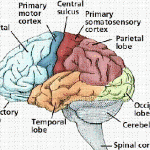 Learn about the structure of the brain, and see different areas of the brain. An interesting journey into how the brain is set up.
Learn about the structure of the brain, and see different areas of the brain. An interesting journey into how the brain is set up.
- Brain Regions: Learn about the different regions of the brain. Helpful labeling lets you see the names of the brain’s various regions. When you are reading or hearing about different parts of the brain, this is a helpful infographic with a quick reference to where each region is located in the brain.
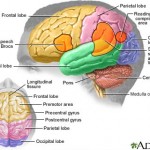 Brain regions and what they do: If you are interested in seeing what the different regions of the brain are responsible for, this infographic is quite enlightening. It offers a look at what goes on in different areas, such as the fact that reading and comprehension take place in the parietal lobe, near the occipital lobe. You can also see that sensory speech goes over more than one lobe. Color coding makes it easier to identify different regions. It’s a great look at the parts of the brain, along with some interesting information on where some common functions are located. Includes a top view as well, allowing you see everything from a different perspective.
Brain regions and what they do: If you are interested in seeing what the different regions of the brain are responsible for, this infographic is quite enlightening. It offers a look at what goes on in different areas, such as the fact that reading and comprehension take place in the parietal lobe, near the occipital lobe. You can also see that sensory speech goes over more than one lobe. Color coding makes it easier to identify different regions. It’s a great look at the parts of the brain, along with some interesting information on where some common functions are located. Includes a top view as well, allowing you see everything from a different perspective.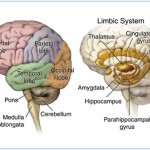 Anatomy of the Brain: Helpful infographic shows the different regions of the brain next to the limbic system. First, find the names of the lobes, and then look at how the limbic system is set up. You can see where different parts of the limbic system in different areas of the brain. Figure out how the limbic system interacts with various lobes in the brain, and learn more about how the brain is set up inside your head. This side by side comparison offers a simple, easy reference that can help you see where things are located. Line them up and compare. A map of your brain’s anatomy that can be quite useful, due to its stripped down simplicity.
Anatomy of the Brain: Helpful infographic shows the different regions of the brain next to the limbic system. First, find the names of the lobes, and then look at how the limbic system is set up. You can see where different parts of the limbic system in different areas of the brain. Figure out how the limbic system interacts with various lobes in the brain, and learn more about how the brain is set up inside your head. This side by side comparison offers a simple, easy reference that can help you see where things are located. Line them up and compare. A map of your brain’s anatomy that can be quite useful, due to its stripped down simplicity.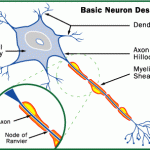 Basic Neuron Design: The basic way that the brain communicates, and how things work in the brain, is through the neurons. If you are interested in seeing how neurons are put together, this is a great infographic. Shows the different parts of the neuron, including the body cell, axon, dendrites and more. Offers a fast and easy way to see all the parts of the neuron, and see how they are designed so that you can better understand how they work and communicate. It’s a pretty basic infographic, but gives you a solid idea of what’s at work when it comes to neurons, and how they are put together in general.
Basic Neuron Design: The basic way that the brain communicates, and how things work in the brain, is through the neurons. If you are interested in seeing how neurons are put together, this is a great infographic. Shows the different parts of the neuron, including the body cell, axon, dendrites and more. Offers a fast and easy way to see all the parts of the neuron, and see how they are designed so that you can better understand how they work and communicate. It’s a pretty basic infographic, but gives you a solid idea of what’s at work when it comes to neurons, and how they are put together in general.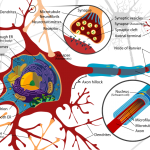 Complete neuron cell diagram: If you are interested in seeing a more complete diagram of a neuron, this is a great infographic. Includes some of the smallest parts found inside the neuron, and helps you see exactly how it all comes together. Includes synapses, receptors, different tubules, microfillaments and hillocks. A very detailed and interesting color illustration of the neuron cell, and what it does.
Complete neuron cell diagram: If you are interested in seeing a more complete diagram of a neuron, this is a great infographic. Includes some of the smallest parts found inside the neuron, and helps you see exactly how it all comes together. Includes synapses, receptors, different tubules, microfillaments and hillocks. A very detailed and interesting color illustration of the neuron cell, and what it does.
Development
How does the brain develop? These infographics address the process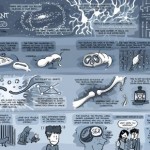 es that make the brain what it is.
es that make the brain what it is.
- Brain Development: This great infographic from the cartoonist behind PhD Comics offers a look at brain development. Attractive and easy to follow, this infographic takes you through the different, essential stages of brain development — and illustrates how many years it takes for the brain’s development to be complete.
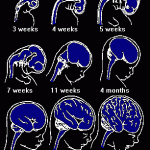 Early Brain Development: This is an infographic that shows very early brain development. Look at how the brain develops in infants in the womb. See the brain development beginning at three weeks and up through newborn. See how different structures are added to the brain, and how they are look at different stages. It’s amazing to see how the brain develops from something so small to the size it is when a baby is born. And, of course, even then the brain is still developing. A fascinating look at brain development in fetuses. The contrasting color is striking, and makes it easy to see.
Early Brain Development: This is an infographic that shows very early brain development. Look at how the brain develops in infants in the womb. See the brain development beginning at three weeks and up through newborn. See how different structures are added to the brain, and how they are look at different stages. It’s amazing to see how the brain develops from something so small to the size it is when a baby is born. And, of course, even then the brain is still developing. A fascinating look at brain development in fetuses. The contrasting color is striking, and makes it easy to see.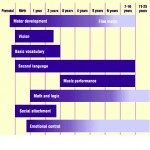 Brain Development Chart: The brain continues to develop through childhood and through the teen years. Indeed, most people’s brains aren’t fully developed until they reach their early 20s. (This explains why teenagers do so many stupid things even though they know better — their brains aren’t done developing!) This basic infographic shows what skills and areas of the brain are developed at different ages throughout life. Math and logic development begins at one year, while motor development begins in the womb. Find other interesting developments from vocabulary to music to social attachment and more.
Brain Development Chart: The brain continues to develop through childhood and through the teen years. Indeed, most people’s brains aren’t fully developed until they reach their early 20s. (This explains why teenagers do so many stupid things even though they know better — their brains aren’t done developing!) This basic infographic shows what skills and areas of the brain are developed at different ages throughout life. Math and logic development begins at one year, while motor development begins in the womb. Find other interesting developments from vocabulary to music to social attachment and more.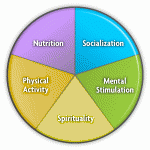 Brain Health Lifestyle: As we get older, our brains can continue to develop — and deteriorate. This simple pie chart infographic offers a look at the five main areas of a brain health lifestyle. These areas include mental stimulation, socialization, nutrition, physical activity and spirituality. This infographic provides a helpful look at balance in your life, and the ways that you can help keep your brain functioning well, and avoid a great deal of deterioration as you age.
Brain Health Lifestyle: As we get older, our brains can continue to develop — and deteriorate. This simple pie chart infographic offers a look at the five main areas of a brain health lifestyle. These areas include mental stimulation, socialization, nutrition, physical activity and spirituality. This infographic provides a helpful look at balance in your life, and the ways that you can help keep your brain functioning well, and avoid a great deal of deterioration as you age.
How the Brain Works
 Learn the ins and outs of how the brain works. Interesting infographics that help illuminate why the brain does what it does.
Learn the ins and outs of how the brain works. Interesting infographics that help illuminate why the brain does what it does.
- Sleep (or how to hack your brain): This fascinating infographic looks at different methods of sleep, and how you can “hack your brain” to get more effective sleep, feeling refreshed on less sleep. It’s an interesting way of organizing your sleeping patterns to make better use of your brain — and your time.
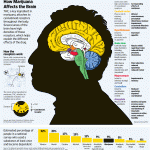 How Pot Affects the Brain: You can get an idea of how your brain works, and how it works on pot, with this infographic. Illustrates how marijuana affects the brain, showing how the brain’s workings are affected by pot, and what happens from the moment the marijuana is introduced into the brain. It’s an interesting look at the way the brain works when under the influence. Make sure you understand how pot works (this infographic makes it easier), and get education about the effects of pot on the brain. A helpful infographic that can help you make up your own mind about pot use.
How Pot Affects the Brain: You can get an idea of how your brain works, and how it works on pot, with this infographic. Illustrates how marijuana affects the brain, showing how the brain’s workings are affected by pot, and what happens from the moment the marijuana is introduced into the brain. It’s an interesting look at the way the brain works when under the influence. Make sure you understand how pot works (this infographic makes it easier), and get education about the effects of pot on the brain. A helpful infographic that can help you make up your own mind about pot use. How Mentalists Read Minds: This is an interesting look into the brain of a mentalist. It looks at facts about communication, and how the brain processes information to interpret communication. Mentalists use a number of tricks to help them “read minds.” This infographic takes a look at some of those tricks, such as noticing the nonverbal communication of a subject, and provides you with helpful hints on how you can train your brain to work in the same — allowing you to understand others better. And perhaps even wow them with your crazy skills and ability to “read” their innermost thoughts.
How Mentalists Read Minds: This is an interesting look into the brain of a mentalist. It looks at facts about communication, and how the brain processes information to interpret communication. Mentalists use a number of tricks to help them “read minds.” This infographic takes a look at some of those tricks, such as noticing the nonverbal communication of a subject, and provides you with helpful hints on how you can train your brain to work in the same — allowing you to understand others better. And perhaps even wow them with your crazy skills and ability to “read” their innermost thoughts. Hack your brain: This cool infographic offers you a chance to find ways to alter your perception using everyday objects. Learn how you can change how your brain works in order to experience interesting hallucinations. Looks at how brain function is affected by different objects, and what you do with them. A cool way to get a mind altering experience without the help of ingested or inhaled substances. Find out how you can alter your own perception. Learn about why these distortions work, and how your brain works to create them when you create the right conditions for them to take place in.
Hack your brain: This cool infographic offers you a chance to find ways to alter your perception using everyday objects. Learn how you can change how your brain works in order to experience interesting hallucinations. Looks at how brain function is affected by different objects, and what you do with them. A cool way to get a mind altering experience without the help of ingested or inhaled substances. Find out how you can alter your own perception. Learn about why these distortions work, and how your brain works to create them when you create the right conditions for them to take place in. Colours in Cultures: Perception is everything when it comes to your brain. And one of the things that different people learn is how colors are perceived. This interesting infographic illustrates the way the brain perceives color in different cultures. The infographic breaks it down into American/Western, Muslim, Eastern European, Hindu, Japanese, Asian and other designations according to large cultural groups. Then you can see how different colors affect perception in the brain. One of the most interesting is Personal Power, which varies quite a bit among cultures. White, though, means Truce almost everywhere.
Colours in Cultures: Perception is everything when it comes to your brain. And one of the things that different people learn is how colors are perceived. This interesting infographic illustrates the way the brain perceives color in different cultures. The infographic breaks it down into American/Western, Muslim, Eastern European, Hindu, Japanese, Asian and other designations according to large cultural groups. Then you can see how different colors affect perception in the brain. One of the most interesting is Personal Power, which varies quite a bit among cultures. White, though, means Truce almost everywhere.
Facts about the Brain
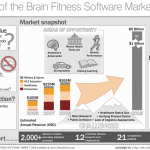 These infographics offer insight and interesting facts about the brain.
These infographics offer insight and interesting facts about the brain.
- Brain Fitness: Are you interested in the state of brain fitness in general? This is an interesting infographic looking at the state of overall brain fitness in our country. It’s a great look at the market for brain products and services. Learn interesting facts, including how much value cognitive tools have, as well as areas of opportunity in a “brain market.”
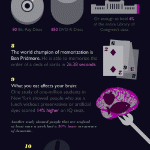 15 Things You Didn’t Know About the Brain: Fascinating infographic that takes you through different facts about the brain. Easy to understand, this presentation shows you different areas of the brain and what they do. On top of this, the infographic includes facts about the brain, such as the fact that the idea that we only use 10% of our brains is a myth. Includes other interesting tidbits about taste, games and other things the brain does. It’s all about the interesting things that you might not know about how your brain works. Find out several things that you might not have known before, all of them about the interesting and mysterious brain.
15 Things You Didn’t Know About the Brain: Fascinating infographic that takes you through different facts about the brain. Easy to understand, this presentation shows you different areas of the brain and what they do. On top of this, the infographic includes facts about the brain, such as the fact that the idea that we only use 10% of our brains is a myth. Includes other interesting tidbits about taste, games and other things the brain does. It’s all about the interesting things that you might not know about how your brain works. Find out several things that you might not have known before, all of them about the interesting and mysterious brain.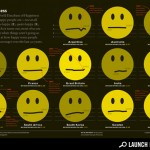 Which Countries Are the Happiest?: Happiness is one of the things that takes place in the brain. This psychological state is an interesting one, and one that affects our every day lives. So, which countries have the happiest citizens? This infographic breaks down factors that contribute to happiness, as well as looks at different factors in different countries that indicate happiness. It’s an interesting look at the facts surrounding this mental state. Look at the cool smiley faces, and see where your country stacks up. The U.S. isn’t the happiest place, but it’s not the least happy, either.
Which Countries Are the Happiest?: Happiness is one of the things that takes place in the brain. This psychological state is an interesting one, and one that affects our every day lives. So, which countries have the happiest citizens? This infographic breaks down factors that contribute to happiness, as well as looks at different factors in different countries that indicate happiness. It’s an interesting look at the facts surrounding this mental state. Look at the cool smiley faces, and see where your country stacks up. The U.S. isn’t the happiest place, but it’s not the least happy, either. The Most Prescribed Psychiatric Drugs: Many people are interested in changing how the brain works. Drugs can be used to do this. Indeed, the use of psychiatric drugs is quite common in the U.S. This infographic offers a look at the facts surrounding the pharmaceutical industry and the most prescribed psychiatric drugs in the country.
The Most Prescribed Psychiatric Drugs: Many people are interested in changing how the brain works. Drugs can be used to do this. Indeed, the use of psychiatric drugs is quite common in the U.S. This infographic offers a look at the facts surrounding the pharmaceutical industry and the most prescribed psychiatric drugs in the country.
Also check:
• https://mastersincounseling.org/education/what-you-need-to-know-about-federal-student-aid/
• https://mastersincounseling.org/counseling/essential-tips/
• https://mastersincounseling.org/counseling/mental-health-counseling/















